WZPK型温度传感器使用说明书
温度传感器的说明书
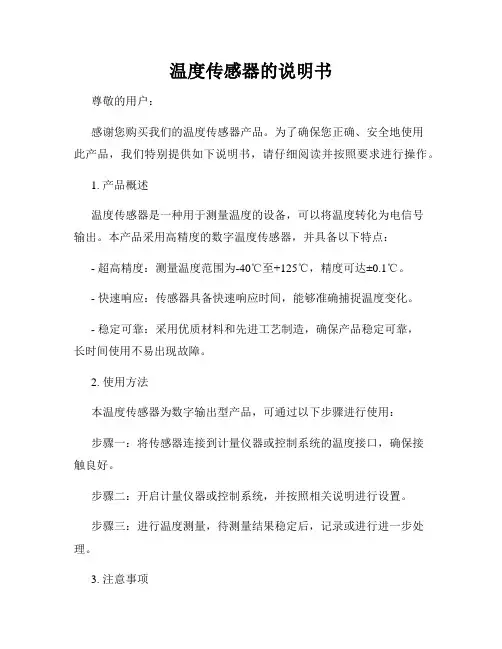
温度传感器的说明书尊敬的用户:感谢您购买我们的温度传感器产品。
为了确保您正确、安全地使用此产品,我们特别提供如下说明书,请仔细阅读并按照要求进行操作。
1. 产品概述温度传感器是一种用于测量温度的设备,可以将温度转化为电信号输出。
本产品采用高精度的数字温度传感器,并具备以下特点:- 超高精度:测量温度范围为-40℃至+125℃,精度可达±0.1℃。
- 快速响应:传感器具备快速响应时间,能够准确捕捉温度变化。
- 稳定可靠:采用优质材料和先进工艺制造,确保产品稳定可靠,长时间使用不易出现故障。
2. 使用方法本温度传感器为数字输出型产品,可通过以下步骤进行使用:步骤一:将传感器连接到计量仪器或控制系统的温度接口,确保接触良好。
步骤二:开启计量仪器或控制系统,并按照相关说明进行设置。
步骤三:进行温度测量,待测量结果稳定后,记录或进行进一步处理。
3. 注意事项为了保障您的安全和正常使用,请注意以下事项:- 请按照产品规定的工作温度范围使用,不要超出额定范围,以免影响测量准确性和传感器寿命。
- 请避免与水、油等液体直接接触,以免影响传感器性能和使用寿命。
- 请勿在高温、高湿度、强酸碱等恶劣环境中使用,以免损坏传感器。
- 避免传感器受到强磁场或电磁辐射的干扰,可能会导致测量偏差。
4. 维护保养- 定期清洁传感器外壳,可使用干净的软布轻擦,不要使用有机溶剂或大量水直接清洗。
- 如发现传感器接触异常或测量不准确,请及时联系售后服务,不要私自拆卸或修理。
5. 售后服务如有任何关于产品的使用问题或售后需求,请随时联系我们的客户服务团队,我们将竭诚为您提供技术支持和解决方案。
感谢您对我们产品的信任和支持,我们将一如既往地致力于为您提供高品质的产品和专业的服务。
祝您使用愉快!此致,敬礼。
厂商名称日期。
温度传感器说明书
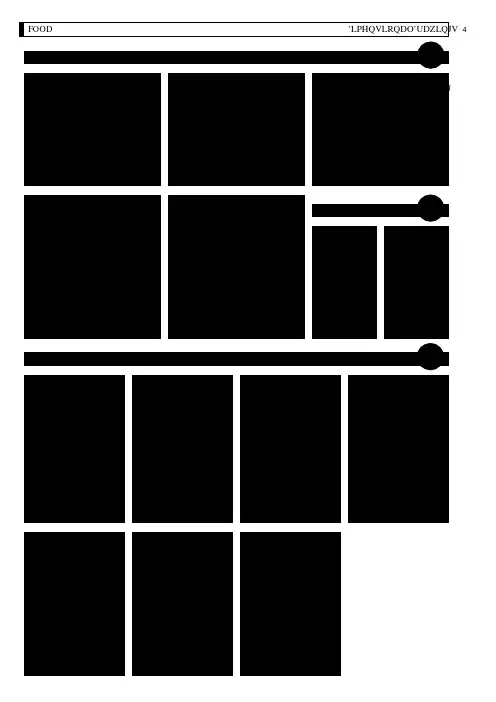
DimensionalDrawings 4
Electricalconnection|HeadBig
Headunitwith1transmitter n( odisplay)andM12plug
Headunitwith1transmitter n( odisplay)andcablegland
V01
B
52.7 / 2.09
V52
F
66.0 / 2.60
V04
N
84.0 / 3.31
D2 [mm/inch] 31.0 / 1.22 50.0 / 1.97 68.0 / 2.68
FOOD
Processconnectionswithextendedtemperaturerange
CH|1 CLEANadaptM21
6mm
t50¡1.8s t90¡5.2s D: 8, 10, 12 mm
D
4mm
t50¡1.2s t90¡3.5s D: 6, 8, 10 mm
D
3mm
t50¡0.8s t90¡s2. D: 6 mm
D
4
3
d
Front“- ush t50¡2.5s t90¡15s
14 [0.55]
7 Installation|Warnings
Disposal
· Electrical devices should not be disposed of with household trash. They must be recycled in accordance with national laws and regulations.
· Take the device directly to a specialized recycling company and do not use municipal collection points.
麦克传感器 WZ 型温度传感器 产品说明书
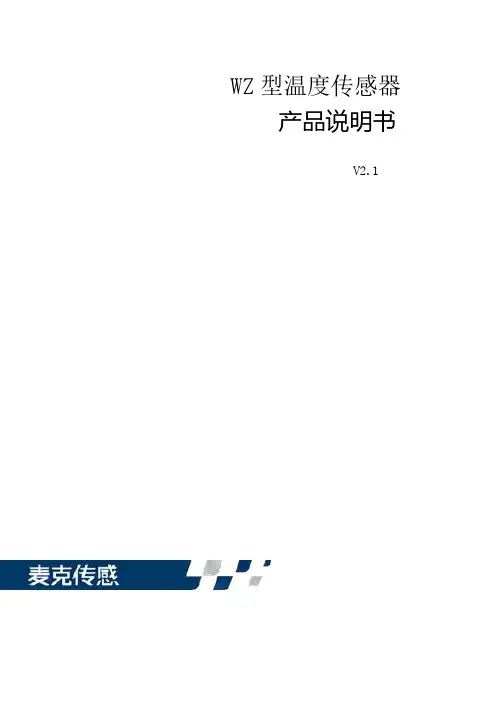
WZ型温度传感器产品说明书V2.1本公司保留由于产品技术和工艺更新对本说明书的修改权。
若有更改,不再另行通知。
请注意本说明书的最新版本。
本公司保留对本说明书的最终解释权。
非常感谢您选用麦克传感器股份有限公司的产品。
为了更好地使用本产品,建议您在使用该产品之前仔细阅读说明书。
1概述WZ型温度传感器是我公司生产的温度传感器中的一个系列,它测温精度高,温度范围宽,可直接测量各种生产过程中的液体、蒸汽、气体介质以及固体表面温度。
2性能指标2外形结构2.1结构材料接触介质材料:304/316不锈钢、其他敏感元件:PT100、PT1000、热电偶防爆(水)接线盒:铝合金其它壳体材质:不锈钢2.2外形尺寸单位为毫米防爆接线盒图1外形尺寸3安装3.1安装前检查本产品在安装前应检查以下几点:a)对照变送器产品名牌的测量范围是否适应现场的实际测量需求;b)检查安装方式、安装螺纹尺寸是否符合现场的实际情况。
3.2安装图2按照示意图温度传感器的安装方式为投入式安装。
产品探头直接没入介质部分,利用探头上的电缆与周围环境连接来固定传感器,防止传感器脱离或移出介质部分。
投入式安装方式示意图见图2。
注1:温度传感器的安装方向应为任意方向,必须使温度传感器测温端充分接触测量介质,保证保护管插入深度。
在有压力的管道测量时,注意安装连接处的密封环节。
注2:安装时切记一定要用扳手或其它工具拧紧螺母,勿用手直接拧动接线盒、表头,以防将传感器内部的线路拧断。
3.3电气连接接线端子示意图见图3图3接线端子说明:热电阻与变送器模块或PLC连接的接线方式,请参照变送器模块或PLC说明书;产品默认为三线制,若需要两线制,请将多余的线作为备用空置。
4开箱及成套性4.1开箱开箱时应注意:a)首先检查包装箱是否完整无缺,箱体应按“↑”标志放置;b)开箱时避免用力过大的敲打,以免损伤仪表或附件。
4.2成套性传感器出厂时应包括:a)温度传感器1台;b)产品说明书1份;c)产品合格证1份。
铠装热电阻

铠装热电阻铠装热电阻是一种温度传感器,利用物质在温度变化时,其电阻也随着发生变化的特征来测量温度的。
当阻值变化时,工作仪表便显示出阻值所对应的温度值。
它比装配式铂电阻直径小,易弯曲,适合安装在管道狭窄和要求快速反应、微型化等特别场合。
其可对—200~600℃温度范围内的气体、液体介质和固体表面进行自动检测,并且可直接用铜导线和二次仪表相连接使用,由于它具有良好的电输出特性,可为显示仪、记录仪、调整器、扫描器、数据记录仪以及电脑供给精准明确的输入值。
目录进展历程如何选择工作原理进展历程从1974年引入薄膜技术研发薄膜铂热电阻元件,成功解决铂热电阻元件的成本及应用问题起,至今已有30多年的历史,随着照相平板印刷技术的日益进展,薄膜铂热电阻元件近几年的进展突飞猛进。
热效应进行温度测量的,即电阻体的阻值随温度的变化而变化的特性。
因此,只要测量出感温热电阻的阻值变化,就可以测量出温度。
隔爆型热电阻通过特别结构的接线盒,装配式热电偶把其外壳内部爆炸性混合气体因受到火花或电弧等影响而发生的爆炸局限在接线盒内,生产现场不会引超爆炸。
隔爆型热电阻可用于具有爆炸不安全场所的温度测量。
热电阻的测温原理与热电偶的测温原理不同的是,热电阻是基于电阻。
的进展,在很大程度上取决于其核心部件,铂热电阻元件的进展。
从传统的云母铂热电阻元件、陶瓷铂热电阻元件、玻璃铂热电阻元件到厚膜铂热电阻元件和薄膜铂热电阻元件,铂热电阻元件的进展方向已转移到膜式结构的产品上,尤其是薄膜铂热电阻元件。
重要技术参数电气出口:M20x1.5,NPT1/2精度等级:I、II防护等级:IP65偶丝直径:Φ0.5公称压力:常压量程规格型号分度号测温范围精度等级允许偏差WZPK—200~600PT100A级—200~600℃时允差±(0.15+0.002|t|)如何选择依据测温范围选择:500℃以上一般选择热电偶,500℃以下一般选择热电阻;依据测量精度选择:对精度要求较高选择热电阻,对精度要求不高选择热电偶;依据测量范围选择:热电偶所测量的一般指“点”温,热电阻所测量的一般指空间平均温度;2线制热电阻配线简单,但要带进引线电阻的附加误差。
教你各类温度测试仪的正确使用方法!
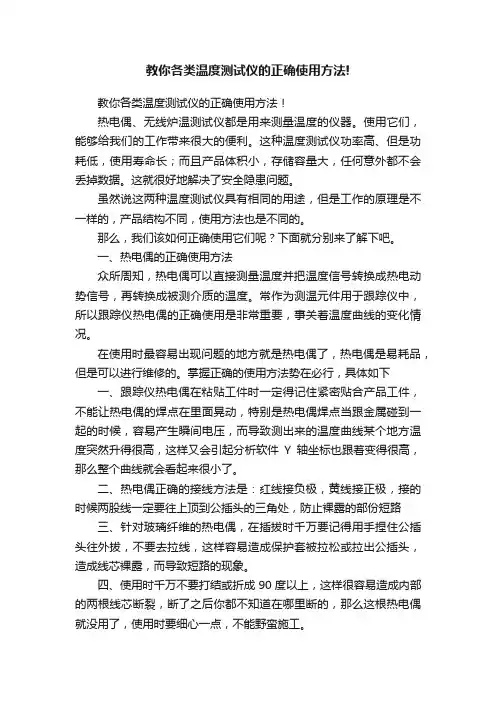
教你各类温度测试仪的正确使用方法!教你各类温度测试仪的正确使用方法!热电偶、无线炉温测试仪都是用来测量温度的仪器。
使用它们,能够给我们的工作带来很大的便利。
这种温度测试仪功率高、但是功耗低,使用寿命长;而且产品体积小,存储容量大,任何意外都不会丢掉数据。
这就很好地解决了安全隐患问题。
虽然说这两种温度测试仪具有相同的用途,但是工作的原理是不一样的,产品结构不同,使用方法也是不同的。
那么,我们该如何正确使用它们呢?下面就分别来了解下吧。
一、热电偶的正确使用方法众所周知,热电偶可以直接测量温度并把温度信号转换成热电动势信号,再转换成被测介质的温度。
常作为测温元件用于跟踪仪中,所以跟踪仪热电偶的正确使用是非常重要,事关着温度曲线的变化情况。
在使用时最容易出现问题的地方就是热电偶了,热电偶是易耗品,但是可以进行维修的。
掌握正确的使用方法势在必行,具体如下一、跟踪仪热电偶在粘贴工件时一定得记住紧密贴合产品工件,不能让热电偶的焊点在里面晃动,特别是热电偶焊点当跟金属碰到一起的时候,容易产生瞬间电压,而导致测出来的温度曲线某个地方温度突然升得很高,这样又会引起分析软件Y轴坐标也跟着变得很高,那么整个曲线就会看起来很小了。
二、热电偶正确的接线方法是:红线接负极,黄线接正极,接的时候两股线一定要往上顶到公插头的三角处,防止裸露的部份短路三、针对玻璃纤维的热电偶,在插拔时千万要记得用手捏住公插头往外拔,不要去拉线,这样容易造成保护套被拉松或拉出公插头,造成线芯裸露,而导致短路的现象。
四、使用时千万不要打结或折成90度以上,这样很容易造成内部的两根线芯断裂,断了之后你都不知道在哪里断的,那么这根热电偶就没用了,使用时要细心一点,不能野蛮施工。
在操作上要特别注意不要损坏热电偶,不然就会导致跟踪仪测量出来的温度曲线出现异常,影响产品的质量。
二、无线炉温测试仪的正确使用方法温度测试仪可能你知道,但是大家对温度测试仪的操作方法知道多少,是不是只是照着说明书上面的看一看就开始操作起来了,而对于温度测试仪的操作要点仍然不了解多少。
IWPT系列无线温度传感器操作手册说明书
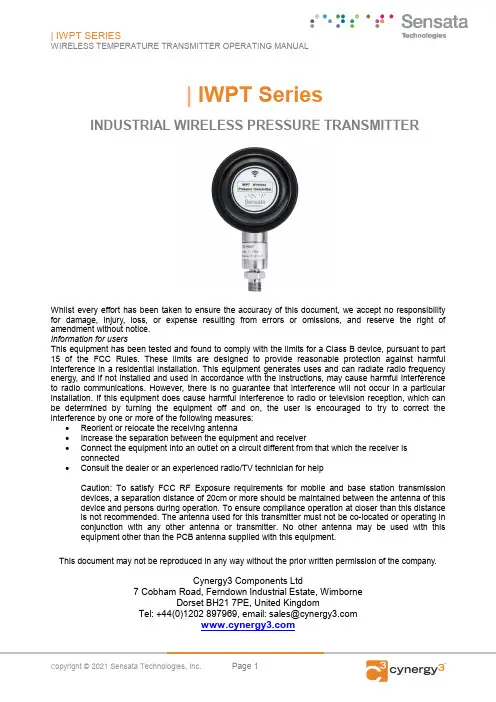
|IWPT SeriesINDUSTRIAL WIRELESS PRESSURE TRANSMITTERWhilst every effort has been taken to ensure the accuracy of this document, we accept no responsibility for damage, injury, loss, or expense resulting from errors or omissions, and reserve the right of amendment without notice.Information for usersThis equipment has been tested and found to comply with the limits for a Class B device, pursuant to part 15 of the FCC Rules. These limits are designed to provide reasonable protection against harmful interference in a residential installation. This equipment generates uses and can radiate radio frequency energy, and if not installed and used in accordance with the instructions, may cause harmful interference to radio communications. However, there is no guarantee that interference will not occur in a particular installation. If this equipment does cause harmful interference to radio or television reception, which can be determined by turning the equipment off and on, the user is encouraged to try to correct the interference by one or more of the following measures:•Reorient or relocate the receiving antenna•Increase the separation between the equipment and receiver•Connect the equipment into an outlet on a circuit different from that which the receiver is connected•Consult the dealer or an experienced radio/TV technician for helpCaution: To satisfy FCC RF Exposure requirements for mobile and base station transmission devices, a separation distance of 20cm or more should be maintained between the antenna of this device and persons during operation. To ensure compliance operation at closer than this distance is not recommended. The antenna used for this transmitter must not be co-located or operating in conjunction with any other antenna or transmitter. No other antenna may be used with this equipment other than the PCB antenna supplied with this equipment.This document may not be reproduced in any way without the prior written permission of the company.Cynergy3 Components Ltd7 Cobham Road, Ferndown Industrial Estate, WimborneDorset BH21 7PE, United KingdomTel:+44(0)1202897969,email:******************CONTENTS1.INTRODUCTION _______________________________________________________ 21.1 SAFETY INFORMATION _____________________________________________________ 21.2HARDWARE FEATURES ____________________________________________________ 22.UNPACKING__________________________________________________________ 33.PRODUCT IDENTIFICATION LABEL _____________________________________ 35.SETTING UP THE IWPT WIRELESS PRESSURE TRANSMITTER ___________ 46.TROUBLE-SHOOTING GUIDE__________________________________________ 67.SYSTEM PART NUMBERS______________________________________________ 78.SPECIFICATIONS & CERTIFICATIONS__________________________________ 9 1. INTRODUCTION1.1 Safety InformationThis manual contains information that must be observed in the interest of your safety and to avoid damage to assets. Please read this manual before installing and commissioning the device and keep the manual in an accessible location for all users.Contains FCC ID: W70MRF24J40MDMECaution: To satisfy FCC RF Exposure requirements for mobile and base station transmission devices, a separation distance of 20cm or more should be maintained between the antenna of this device and persons during operation. To ensure compliance operation at closer than this distance is not recommended. The antenna used for this transmitter must not be co-located or operating in conjunction with any other antenna or transmitter. No other antenna may be used with this equipment other than the PCB antenna supplied with this equipment.Please see the Certifications section for more information on RF Exposure Compliance 1.2 Hardware FeaturesThe IWPT range of Wireless Pressure Transmitters has been designed to measure the pressure of the medium connected and transmit the value to one of the IWR range of receivers where the value can be outputted as either a 4-20 mA or 1-5 V dc signal.The IWR-1 has a single output and the IWR-5 has five outputs, each of which can be linked to an IWPT transmitter. The IWPT pressure transmitter works on the license-free 2.4 GHz band.Ranges of up to 500 m are possible using the standard transmitter and receiver unit with the optional 3dBi antenna giving a range of up to 750 m. The transmitter is powered by a 3.6V lithium cell and care must be taken to insert the battery in the correct polarity.2. UNPACKINGThe instrument should be carefully inspected for signs of damage that may have occurred in transit. In the unlikely case that damage has been sustained, DO NOT use the instrument, but please retain all packaging for our inspection and contact your supplier immediately.3. PRODUCT IDENTIFICATION LABELThe unit delivered should be carefully inspected to ensure it is suitable for the application required. Detailed information on the product is included in the identification label and the user manual.Please ensure in particular, that the pressure range of the IWPT is suitable for the intended application and that the IWPT unit will not be subjected to pressures and/or temperatures greater than those specified in this manual.4.INSTALLING/CHANGING THE BATTERYA Lithium 3.6V battery is included inside the IWPT transmitter. The battery may be changed at any time but the correct polarity must be observed at all times! After the battery has been changed, the pushbutton SW1 should be pushed for 5s at the same time as the unit is switched on using SW3. This is to ensure the battery life count is set correctly when a new battery is installed.The internal LED will flash 5 times to indicate this procedure has been carried out successfully.The battery life is determined by the rate the transmitter sends the Pressure value to the receiver, this update rate can be selected using Dip Switch 1 and the default value is 10s. Please dispose of all batteries as specified by the legislator according to the Closed Substance Cycle and Waste Management Act or country regulations.! ! WARNING !MAKE SURE THE CORRECT BATTERY POLARITY IS OBSERVED!!! WARNING !INCORRECT BATTERIES MAY DAMAGE THE UNIT USE ONLY 3.6V LITHIUM C CELL BATTERIES5.1 Mounting InstructionsEnsure that:-- The instrument is used on a pressure medium that is compatible with the wetted parts- The correct seal is used and that the maximum torque (see below) is not exceeded- Fluid is not allowed to freeze in the pressure port as the diaphragm may be ruptured- No sharp objects are inserted into the pressure port as the diaphragm may be damagedTighten the unit in place using a wrench on the 18mm A/F hexagon provided on the unit. Ensure that no more than 15Nm is applied, that the system is de-pressurized, and that a suitable pressure seal is used.5.2 SETTING UP THE IWPT WIRELESS PRESSURE TRANSMITTERThe IWPT instrument is shipped in a default configuration which allows the unit to connect with any default IWR receiver unit and transmit the measured pressure every 10s simply by switching the unit on using SW3 on the internal circuit board.If a different update rate is required, or a different network frequency channel is required these parameters can be selected using DIP Switch 1 as detailed below:Switches 1, 2, 3 & 4 select the RF Network the IWPT will transmit on. The default network for both the IWPT transmitter and IWR receiver is network 1. RF NETWORK 1 2 3 4 1 0 0 0 0 2 0 0 0 1 3 0 0 1 0 4 0 0 1 1 5 0 1 0 0 6 0 1 0 1 7 0 1 1 0 8 0 1 1 1DIP SWITCHLED1BATTERYON/OFF Switch SW3SW1USB+9 1 0 0 010 1 0 0 111 1 0 1 012 1 0 1 113 1 1 0 014 1 1 0 115 1 1 1 016 1 1 1 1Switches 5, 6 & 7 select the Transmission rate of the unit. This effectively sets how often the pressure value is sent to the receiver.Transmit time 5 6 710 seconds 0 0 020 seconds 0 0 130 seconds 0 1 060 seconds 0 1 1120 seconds 1 0 0600 seconds 1 0 11 second 1 1 05 seconds 1 1 1Switches 8, 9, and 10 set the Channel Number of the transmitter. This is used with the 5 channel receiver unit (IWR-5) to select which Pressure transmitter is linked to which4-20 mA or 1-5 V dc output channel.Tx Channel Number 8 9 101 0 0 02 0 0 13 0 1 04 0 1 15 1 0 0The IWPT transmitter is now set up and ready to be used. Install the unit into the pipework as required and switch the unit ON using SW3. Pushbutton switch SW1 can be pushed to force the unit to transmit its current pressure and LED 1 will flash twice if the transmission has been received and acknowledged by an IWR receiver unit.If the unit has transmitted successfully the 4-20 mA or 1-5 V dc output of the connected receiver unit will output a value reflecting the pressure level being measured.6.TROUBLE-SHOOTING GUIDEProblem encountered Possible CausesLED1 doesn’t flash when push button SW1 is pressed Unit not switched on, switch on using SW3. The battery is not installed correctly.The battery needs replacing.LED1 only flashes once when SW1 is pressed IWR receiver not switched on. IWR receiver is not set up for the same RFnetwork.IWR receiver not within range of the transmitter.If an IWR-1 receiver is used, ensure that the transmitter is set to Tx Channel 1Output from the IWR receiver isn’t equivalent to the Pressure being monitored IWR receiver set up incorrectly, see IWR user manual for further details.Check that the green external LED on the receiver is flashing when the transmitter push button is pressed as the receiver may be out of range.7. SYSTEM PART NUMBERSPart Number Pressure Range Receiver Output IWPT-G1000-00 0-1 Bar g 4-20 mA or 1-5 V dc IWPT-G6000-00 0-6 Bar g 4-20 mA or 1-5 V dc IWPT-GM1P9-00 -1-+9 Bar g 4-20 mA or 1-5 V dc IWPT-G1002-00 0-10 Bar g 4-20 mA or 1-5 V dc IWPT-G1602-00 0-16 Bar g 4-20 mA or 1-5 V dc IWPT-CO184-00 -1-+24 Bar g 4-20 mA or 1-5 V dc IWPT-G2502-00 0-25 Bar g 4-20 mA or 1-5 V dc IWPT-G4002-00 0-40 Bar g 4-20 mA or 1-5 V dc IWPT-G1003-00 0-100 Bar g 4-20 mA or 1-5 V dc IWPT-G2503-00 0-250 Bar g 4-20 mA or 1-5 V dc IWPT-G4003-00 0-400 Bar g 4-20 mA or 1-5 V dc IWPTU-GP015-00 0-15 psi g 4-20 mA or 1-5 V dc IWPTU-GP030-00 0-30 psi g4-20 mA or 1-5 V dc IWPTU-CO446-00 -14.5 to +150 psi g4-20 mA or 1-5 V dc IWPTU-GP075-00 0-75 psi g4-20 mA or 1-5 V dc IWPTU-GP100-00 0-100 psi g4-20 mA or 1-5 V dc IWPTU-CO447-00 -14.5 to +350 psi g4-20 mA or 1-5 V dc IWPTU-GP150-00 0-150 psi g4-20 mA or 1-5 V dc IWPTU-GP300-00 0-300 psi g4-20 mA or 1-5 V dc IWPTU-GP750-00 0-750 psi g4-20 mA or 1-5 V dc IWPTU-GP1K5-00 0-1500 psi g4-20 mA or 1-5 V dc IWPTU-GP3K6-00 0-3600 psi g4-20 mA or 1-5 V dc IWPTU-GP5K8-00 0-5800 psi g4-20 mA or 1-5 V dc IWPTL-G0050-00 0-50 mbar g 4-20 mA or 1-5 V dc IWPTL-G0100-00 0-100 mbar g 4-20 mA or 1-5 V dc IWPTL-G0250-00 0-250 mbar g 4-20 mA or 1-5 V dc IWPTL-G0500-00 0-500 mbar g 4-20 mA or 1-5 V dc IWPTL-G0750-00 0-750 mbar g 4-20 mA or 1-5 V dc IWPTL-G1000-00 0-1000 mbar g 4-20 mA or 1-5 V dc IWPTL-A0500-00 0-500 mbar abs 4-20 mA or 1-5 V dc IWPTL-A0750-00 0-750 mbar abs 4-20 mA or 1-5 V dc IWPTL-A1000-00 0-1000 mbar abs 4-20 mA or 1-5 V dcPart Number Pressure Range Receiver Output IWPTLU-GP001-00 0-1 psi g 4-20 mA or 1-5 V dc IWPTLU-GP002-00 0-2 psi g 4-20 mA or 1-5 V dc IWPTLU-GP005-00 0-5 psi g 4-20 mA or 1-5 V dc IWPTLU-GP008-00 0-8 psi g 4-20 mA or 1-5 V dc IWPTLU-GP010-00 0-10 psi g 4-20 mA or 1-5 V dc IWPTLU-GP015-00 0-15 psi g 4-20 mA or 1-5 V dc IWPTLU-AP005-00 0-5 psi abs 4-20 mA or 1-5 V dc IWPTLU-AP010-00 0-10 psi g 4-20 mA or 1-5 V dc IWPTLU-AP015-00 0-15 psi g 4-20 mA or 1-5 V dcPart Number Number of Output ChannelsIWR-1 OneIWR-5 FiveIANT-3 3 dBi Antenna IWPT-SA Swivel Adaptor (1/4” BSP)8.SPECIFICATIONS & CERTIFICATIONSUnited States FCCThis equipment has been tested and found to comply with the limits for a Class B device, pursuant to part 15 of the FCC Rules. These limits are designed to provide reasonable protection against harmful interference in a residential installation. This equipment generates, uses, and can radiate radio frequency energy, and if not installed and used in accordance with the instructions, may cause harmful interference to radio communications. However, there is no guarantee that interference will not occur in a particular installation. If this equipment does cause harmful interference to radio or television reception, which can be determined by turning the equipment off and on, the user is encouraged to try to correct the interference by one or more of the following measures:• Reorient or relocate the receiving antenna• Increase the separation between the equipment and receiver• Connect the equipment into an outlet on a circuit different from that which the receiver is connected • Consult the dealer or an experienced radio/TV technician for helpWarning: Changes or modifications not expressly approved by Cynergy3 could void the user’s authority to operate the equipment.RF ExposureContains FCC ID: W70MRF24J40MDMEIn this equipment, the antenna supplied is a PCB antenna and an alternative antenna must not be used.System PerformanceAccuracy (non-linearity & hysteresis <±0.25% / FS (BFSL)Setting ErrorsZero & Full Scale,<±0.5% / FS Thermal Zero Shift <±0.04% / FS / °C Thermal Span Shift <±0.02% / °C typicalMedia Temperature -20 to +135 °C Ambient Temperature -20 to +50 °C Storage Temperature -20 to +80 °CPressure Housing 303 Stainless Steel O Ring Seals Viton DiaphragmCeramic Enclosure Material Acetal Weight310 gRF TransmitterContains FCC W70MRF24J40MDME Power Requirements Lithium Ion C 3.6V CellBattery Life 5 Years (10s transmission rate)Dimensions 132mm x 79mm x 52mm (L x W x D) Mounting Any OrientationSensata Technologies, Inc. (“Sensata”) data sheets are solely intended to assist designers (“Buyers”) who are developing systems that incorporate Sensata products (also referred to herein as “components”). Buyer understands and agrees that Buyer remains responsible for using its independent analysis, evaluation and judgment in designing Buyer’s systems and products. Sensata data sheets have been created using standard laboratory conditions and engineering practices. Sensata has not conducted any testing other than that specifically described in the published documentation for a particular data sheet. Sensata may make corrections, enhancements, improvements and other changes to its data sheets or components without notice.Buyers are authorized to use Sensata data sheets with the Sensata component(s) identified in each particular data sheet. HOWEVER, NO OTHER LICENSE, EXPRESS OR IMPLIED, BY ESTOPPEL OR OTHERWISE TO ANY OTHER SENSATA INTELLECTUAL PROPERTY RIGHT, AND NO LICENSE TO ANY THIRD PARTY TECHNOLOGY OR INTELLECTUAL PROPERTY RIGHT, IS GRANTED HEREIN. SENSATA DATA SHEETS ARE PROVIDED “AS IS”. SENSATA MAKES NO WARRANTIES OR REPRESENTATIONS WITH REGARD TO THE DATA SHEETS OR USE OF THE DATA SHEETS, EXPRESS, IMPLIED OR STATUTORY, INCLUDING ACCURACY OR COMPLETENESS. SENSATA DISCLAIMS ANY WARRANTY OF TITLE AND ANY IMPLIED WARRANTIES OF MERCHANTABILITY, FITNESS FOR A PARTICULAR PURPOSE, QUIET ENJOYMENT, QUIET POSSESSION, AND NON-INFRINGEMENT OF ANY THIRD PARTY INTELLECTUAL PROPERTY RIGHTS WITH REGARDTO SENSATA DATA SHEETS OR USE THEREOF.All products are sold subject to Sensata’s terms and conditions of sale supplied at SENSATA ASSUMES NO LIABILITY FOR APPLICATIONS ASSISTANCE OR THE DESIGN OF BUYERS’ PRODUCTS. BUYER ACKNOWLEDGES AND AGREES THAT IT IS SOLELY RESPONSIBLE FOR COMPLIANCE WITH ALL LEGAL, REGULATORY AND SAFETY-RELATED REQUIREMENTS CONCERNING ITS PRODUCTS, AND ANY USE OF SENSATA COMPONENTS IN ITS APPLICATIONS, NOTWITHSTANDING ANY APPLICATIONS-RELATED INFORMATION OR CONTACT US EUROPE+44 (0)1202 897969********************* Cynergy3 Components Ltd.7 Cobham Road, Ferndown Industrial Estate, Wimborne, Dorset,BH21 7PE, United Kingdom USACaution: To satisfy FCC RF Exposure requirements for mobile and base station transmission devices, a separation distance of 20cm or more should be maintained between the antenna of this device and persons during operation. To ensure compliance operation at closer than this distance is not recommended. The antenna used for this transmitter must not be co-located or operating in conjunction with any other antenna or transmitter. No other antenna may be used with this equipment other than the PCB antenna supplied with this equipment.Canada (IC)EnglishThis device complies with Industry Canada license-exempt RSS standard(s). Operation is subject to the following two conditions: (1) this device may not cause interference, and (2) this device must accept any interference, including interference that may cause undesired operation of the device.Under Industry Canada regulations, this radio transmitter may only operate using an antenna of the type and maximum (or lesser) gain approved for the transmitter by Industry Canada. To reduce potential radio interference to other users, the antenna type and its gain should be so chosen that the equivalent isotropically radiated power (e.i.r.p.) is not more than that necessary for successful communication. FrenchLe présent appareil est conforme aux CNR d’industrie Canada applicables aux appareils radio exempts de licence. L’explitation est autorisée aux deux conditions suivantes: (1) l’appareil ne doit pas produire de brouillage, et (2) l’utilisateur de l’appareil doit accepter tout brouillage, et (2) l’utilisateur de l’appareil doit accepter tout brouillage radioelectrique subi, même si le brouillage est susceptible d’en compromettre le fonctionnement.Conformément à la réglementation d’Industrie Canada, le présent émetteur radio peut fonctionner avec une antenna d’un type et d’un gain maximal (ou inférieur) approuvé pour l’émetteur par Industrie Canada. Dans le but de réduire les risques de brouillage radioélectrique à I’intention des autres utilisateurs, il fait choisir le type d’antenne et son gain de sorte que la puissance isotrope rayonnée équivalente (p.i.r.e) ne dépasse pas l’intensité nécessaire à l’établissement d’une communication satisfaisante.EuropeThe MRF24J40MD/ME wireless module used in this equipment has been tested to R&TTE Directive 1995/5/EC Essential Requirements for Health and Safety (Article 3.1(a)), Electromagnetic Compatibility (EMC) Article 3.1(b)) and Radio (Article 3.2) and are summarized in the table below. A Notified Body Opinion has also been issued for this module.Certification Standards ArticleSafety EN60950-2006+A11+A1:2010 (3.1(a))Health EN50371:2002-03 (3.1(a))EMC EN301 489-1 V1..8.1 (2008-04_ (3.1(b))EMC EN301-489-17 V2.1.1(2009-05) (3.1(b))Radio EN 300 328 V1.7.1(2006-10) (3.2)。
WZP1温度传感器是用来精确测量土壤温度和水温的传感器
目录1 概述 (2)2 规格 (2)3 原理 (2)4 安装 (2)1 概述WZP1温度传感器是用来精确测量土壤温度和水温的传感器,传感器的精度和稳定性依赖于Pt-100型铂电阻元件的特性及精度级别。
传感器配有5m 、10m的屏蔽电缆,2 规格精度:±0.3℃灵敏度:0.385Ω/℃测量范围:-50℃- +80℃尺寸:直径5mm,长130mm3 原理地温传感器共12支,其中地表温4支,5cm、10cm、15cm、20cm、40cm、80cm、160cm、320cm地温各一支,均为标准4线制铂电阻测温。
(40cm、80cm、160cm、320cm深层地温应配有套管)测量原理是铂导体电阻值随温度升高而增加的特性,具体测量方法如下:测V1、V2值即可求得Rt :恒流源Rt=R0*V1/V2原理图铂电阻计算公式:Rt=R0*(1+At+Bt2)换算出温度计算公式:T=A+B*Rt+C*Rt2A、B 、C为常数。
T为温度(℃),R0为标准电阻值100Ω。
4 安装4支地表温与5cm、10cm、15cm、20cm、40cm浅层地温安放在观测场南面平整出的裸地上,地段面积为2⨯4平方米。
地表疏松、平整、无草,并与观测场整个地面相平。
4支地表温安放在地段中央偏东的地面,感应头向外,4只表以感应头尾部电缆连接端为中心成放射状;感应部分及表身,一半埋入土中,一半露出地面。
埋入土中的感应部分与土壤必需密贴,不可留有空隙;露出地面的感应部分和表身,要保持干净。
5cm、10cm、15cm、20cm、40cm浅层地温安放在地表温中心线线上西边约20厘米处,并用专用安装架安放于土壤中埋好。
80cm、160cm、320cm 深层地温(外有套管)安放在观测场南面浅层地温旁一块地面有自然覆盖物(草皮或浅草层),面积为3 4平方米的范围,地面要保持平坦,草层与整个观测场上草层同高。
按自东向西、由浅而深方式安放,表间相隔50厘米,在地段中部排成一行。
温度传感器使用说明
Executi ng division : Responsible division : Document type : Confidentiality status :HCN NVPTechnical Documentation InternalPrepared :Document state :08.02.2006 Czernietzki (NVP)Technology Transfer HCN PreliminaryChecked :09.02.2006 Czernietzki (NVP)FNC System BusinessThermistorsApproved :File:Revision :Language :Pages :09.02.2006 Czernietzki (NVP) TD-Thermistors-en-R001 001 en 1/19This document and its contents are the property of Hoppecke or its subsidiaries. This document contains confidential proprietary information. The reproduction,Document administration 文件管理Document History 文件记录VersionDateResponsibleReason of change001 08.02.2006 Czernietzki First release of the document.Change justifiable 变更审核Hans-Peter Czernietzki NVPPreparing , Checking , ApprovingLewis Liu HCN QS Preparing , Checking , ApprovingDocument generated with following tools 使用下列工具编写文件:WORD 200 <Grafic tool>Content 目录1 Overview Thermistors........................................................................................................................................................................2 1.1 General.....................................................................................................................................................................................2 1.2 NTC Thermistors.....................................................................................................................................................................4 1.3 PTC Thermistors......................................................................................................................................................................5 1.4 Lead wire configurations..........................................................................................................................................................6 1.5 Available temperature probe....................................................................................................................................................8 1.6 Available connection cables.....................................................................................................................................................8 2 Designs...............................................................................................................................................................................................9 2.1 Stainless steel block version.....................................................................................................................................................9 2.2 Electrolyte version...................................................................................................................................................................9 2.3 Connection cables..................................................................................................................................................................10 2.3.1 Two wire connection 414 220 0802.............................................................................................................................10 2.3.2 Four wire connection 414 220 0804............................................................................................................................10 2.3.3 Connection clamp........................................................................................................................................................10 2.4 Temperature curve PT100B...................................................................................................................................................11 2.5 Temperature curve NTC10K..................................................................................................................................................11 2.6 Technical data NTC10K.........................................................................................................................................................11 3 Attachments......................................................................................................................................................................................11 3.1 Drawing 2BZ60287-01..........................................................................................................................................................11 3.2 Drawing 3BZ60731-01..........................................................................................................................................................11 3.3 Drawing 2BZ60287-02..........................................................................................................................................................11 3.4 Drawing 3BZ60407-01..........................................................................................................................................................11 3.5 Drawing 3BZ60732-01..........................................................................................................................................................11 3.6 Drawing 3BZ60407-02. (11)1 Overview Thermistors电热调节器简介1.1 General总则Resistance elements come in many types conforming to different standards, capable of different temperature ranges, with various sizes and accuracies available. But they all function in the same manner: each has a pre-specified resistance value at a known temperature which changes in a predictable fashion. In this way, by measuring the resistance of the element, the temperature of the element can be determined from tables, calculations or instrumentation. These resistance elements are the heart of the RTD (Resistance Temperature Detector or short: Thermistor). Generally, a bare resistance element is too fragile and sensitive to be used in its raw form, so it must be protected by incorporating it into an housing.电阻元器件满足不同的标准,能够适用不同的温度范围,可满足多种尺寸和精度要求。
热电阻wzpk-440-th参数
热电阻wzpk-440-th参数热电阻是一种温度传感器,常用于工业和家用设备中。
本文将介绍一种热电阻,型号为wzpk-440-th,包括其参数、特点和技术规格。
参数:1.量程:-200℃至600℃2.精度:0.15%FS3.输出信号:Pt100、Pt10004.安装方式:法兰式、插头式5.材质:304不锈钢6.标定温度:0℃7.防护等级:IP67特点:1.高精度:该热电阻的精度高达0.15%FS,能够对温度变化进行高精度测量。
2.高温测量:该热电阻能够测量的温度范围达到600℃。
适用于高温环境下的温度测量。
3.多种安装方式:该热电阻可采用法兰式和插头式安装,适用于不同的安装环境。
4.防护等级高:该热电阻的防护等级达到IP67,能够在恶劣的环境下工作。
技术规格:1.内部滤波器:必要2.震动(工作时):25g,2000 Hz (IEC 68-2-27)3.防护等级:IP674.机械负载:≤±0.05%/1000Ω5.环境温度:-20℃至80℃6.单元温度系数:0.003857.灵敏度:0.1%/℃wzpk-440-th是一种高精度、多功能的热电阻,适用于温度测量范围广泛的工业和家用设备。
为了更好地了解wzpk-440-th热电阻的使用和特点,我们将继续介绍该设备的更多细节。
1.量程wzpk-440-th的量程达到-200℃至600℃,具有广泛的应用范围,可以适用于不同的应用场景,例如在化学、制药和加热等方面被广泛应用。
2.精度wzpk-440-th具有0.15%的高精度,能够准确测量温度变化,非常适用于精确测量和控制温度的应用场景。
该热电阻的响应速度快,可以快速地响应温度变化。
3.多种安装方式wzpk-440-th有两种安装方式可供选择:法兰式和插头式。
法兰式安装适用于直接安装在设备上,而插头式安装适用于需要更换的场所。
不同的场合适用不同的安装方式。
4.防护等级高wzpk-440-th具有IP67级别的防护等级,能够保护热电阻免受周围环境的影响,包括水、油、尘和震动。
WZPK系列铠装铂热电阻
WZPK系列铠装铂热电阻WZPK series armoured platinum thermal resistance安装说明书Installation Manual上海辰心仪表有限公司Shanghai Chenxin Instruments Co.,Ltd铠装铂热电阻安装使用说明书一、概述铠装铂热电阻是由铂电阻元件,内引线、绝缘材料,金属导管组合而成的坚实体。
它作为一种温度传感器通常用来和显示仪表配套,以直接测量和调节-200~600℃范围内的液体、气体、蒸气介质以及固体表面等的温度。
它具有精度高,稳定性好,线径小,可任意弯曲,热响应快,可绕性好,抗震,耐压,抗冲击,适应性强等优点。
二、选择1.根据测量的范围和对象,选择适当的铠装铂热电阻及规格。
2.选用铠装铂热电阻的分度号必须与显示仪表的分度号一致。
3.除双支式的铠装铂热电阻外,在不使用切换开关的情况下,每支铠装铂热电阻不可同时和两台显示仪表连接使用。
三、铠装铂热电阻的基本性能注:①|t|为被测量的绝对值。
②分度号为Pt10、P t100的铠装铂热电阻的电阻一温度关系,符合ZBY301-85《工业铂热电阻技术条件及分度表》标准。
③凡订购分度号为Pt10的铠装铂热电阻,均须由供需双方以“技术协议”的形式供货。
2.绝缘电阻:1).铠装铂热电阻的常温绝缘电阻不大于100MΩ;注:①在测量铠装铂热电阻的常规绝缘电阻时,试验电压可取直流10~100V任意值。
环境温度应在15~35℃,相对湿度应不大于80%。
②在测量铠装铂热电阻的上限温度绝缘电阻值之前,应让铠装铂热电阻在试验温度停留至少30分钟,并记录试验温度值。
试验电压应不超过直流10V。
3.自热影响:单支式铠装铂热电阻的自热试验,其激励电流值不得大于5mA,双支式不得不大3mA测得的电阻增量换算成温度值应不大于0.30℃。
四、安装1. 铠装铂热电阻的安装地点,应避免安装在炉门旁边和避免与加热物体距离过近之处。
- 1、下载文档前请自行甄别文档内容的完整性,平台不提供额外的编辑、内容补充、找答案等附加服务。
- 2、"仅部分预览"的文档,不可在线预览部分如存在完整性等问题,可反馈申请退款(可完整预览的文档不适用该条件!)。
- 3、如文档侵犯您的权益,请联系客服反馈,我们会尽快为您处理(人工客服工作时间:9:00-18:30)。
WZPK型温度传感器
使用说明书
泰兴市热工仪表厂2015年01月10日
隔爆温度传感器
■应用
通常和显示仪表、记录仪表、电子计算机等配套使用。
直接测量生产现场存在碳氢化合物等爆炸的0~500℃范围内液体、蒸汽和气体介质以及固体表面温度。
■特点
●压簧式感温元件,抗振性能好;
●测量范围大;
●毋须补偿导线,节省费用;
●进口薄膜电阻元件,性能可靠稳定。
●防爆标志:Ex dⅡBT1~T5,防爆合格证号:GYB
■主要技术参数
●产品执行标准
JB/T8622-1997 《工业铂热电阻技术条件》
《爆炸性气体环境用电气设备第1部分:设备通用要求_部分2》和《爆炸性气体环境用电气设备第2部分:隔爆型“d”保护的设备》,《设备保护等级(EPL)为Gb级的设备产品防爆标志为Ex d ⅡB T1~T5 Gb
■常温绝缘电阻
防爆热电阻在环境温度为15~35℃,相对湿度不大于80%,试验电压为10~100V(直流)电极及外套管之间的绝缘电阻≥100MΩ.m。
■测温范围及允差
●测温范围及允差
注:t为感温元件实测绝对值。
●防爆分组形式
d Ⅱ□ T □
温度组别:T1~T5
防爆等级:A、B、C
工厂用电气设备
d:隔爆型
ai:本质安全型
○电气设备类别
Ⅰ类——煤矿井下用电气设备
Ⅱ类——工厂用电气设备
○防爆等级
防爆热电偶的防爆等级按其使用于爆炸性气体混合物最大安
全间隙分为A、B、C三级。
○温度组别
防爆热电偶的温度组别按其外漏部分允许最高表面温度分为T1~T5
●防爆等级
●Exd Ⅱ□T□
●Exia Ⅱ□T□
●防护等级:IP65
■接线盒形式
●dⅡBT□级
■安装端子形式
显示
控制
线路
■安装及注意事项
●产品使用环境:-20~60℃
●产品设有接地端子,用户在使用产品时应可靠接地。
●现场安装,维护必须遵守“先断电,后开盖”的警告语。
●引入本质安全型电缆外径为Φ~Φ10的三芯导线,现场使用应拧紧
压紧螺母,使密封圈内径紧紧抱住电缆外径。
密封圈老化时应及时更换,不得用代替品,且必须向生产厂索取。
●引入电缆接线时,注意各接线片之间,导线之间及它们与外壳之
间的电气间隙和爬电距离不得小于4mm,旋紧盖后,用螺钉旋紧锁紧卡。
●安装现场应不存在对铝合金有腐蚀作用的有害气体。
●产品的温度等级与防爆产品和设备之间外露在环境汇总的最高表
面温度不得超过下表规定
●维护必须在安全场所进行,当安装现场确认无可燃性气体存在时,
方可维修。
●产品的安装、使用和维护,须同时严格遵守“爆炸性气体环境用
电气设备第13部分:爆炸性气体环境用电气设备的检验”、GB “爆炸性气体环境用电气设备第15部分:危险场所电气安装(煤矿除外)”、“爆炸性气体环境用电气设备第16部分:电气装置的检查和维护(煤矿除外)”和GB50257:1996“电气设备安装工程爆炸和火灾危险环境电气装置施工及验收规范”的有关规定。
■型号命名方法
隔爆型
附加现场显示型
船用型
输出4~20mA
电阻值
Φ12单保护管
Φ16双保护管
可动内螺纹接头
可动外螺纹皆有
活动法兰式
固定法兰式
铠装式
铂电阻传感器
热电阻
温度仪表
■选型须知
1)型号
2)分度号
3)防爆等级
4)精度等级
5)安装固定形式
6)保护管材质
7)长度或插入深度
例A:防爆热电阻,Pt100型,固定螺纹M27×2,防爆等级d ⅡBT4级,保护管316,插入深度300㎜。
WZPK-22R-C-B,Pt100,l=300,iaⅡCT4级,保护管316,螺纹M27×2。
防爆热电阻。
